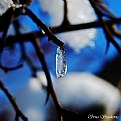
Jeroen Wenting
 (K=25317) - Comment Date 11/29/2002
(K=25317) - Comment Date 11/29/2002
|
A little physics is required here (which I don't have exact at the top of my head, but I'll try).
Visible light passing through a polarising medium can become polarised either linear or circular (dependin on the physical properties of the material).
To the human eye there is no difference (as the human eye cannot see polarisation).
To modern cameras though there is a difference. There is a mechanism that divides the incoming light into several rays. This is accomplished via linear polarisation. One ray is diverted to the lightmeter, the other to the autofocus sensor.
When you use a linear polariser, the light intensity of the two split rays is not the same. This leads to an incorrect reading of the light conditions by the meter.
When you use a circular polariser, linear polarisation of the resulting light will still provide the exact percentage of the original light that would fall on the film to reach the sensor of the light meter.
As a result, the meter can now perform correct calculations, something it would be unable to do if you were using a linear polariser.
You might think you could simply add a switch or button to the camera causing it to correct for linear polarisers. Sadly it is not that simple as the correction factor would have to depend on the polarisation angle provided by the linear polariser (with all resulting messiness). And what if someone decided to use 2 polarisers (there's always someone :-) ).
|
|
|
|

Uncle Frank
(K=1642) - Comment Date 11/29/2002
|
"There is a mechanism that divides the incoming light into several rays. This is accomplished via linear polarisation. One ray is diverted to the lightmeter, the other to the autofocus sensor. When you use a linear polariser, the light intensity of the two split rays is not the same. This leads to an incorrect reading of the light conditions by the meter."
Actually that was my point, Jeroen, since digital cameras (with the exception of the E10/20, I believe), don't use a split beam approach. That being the case, a linear polarizer should be an easier but equally effective solution, right?
|
|
|
|

Markos Berndt
(K=382) - Comment Date 11/29/2002
|
When I use a circ polar I see a difference both on the lcd and EVF. When I turn it I see on the screen. I posted a image pre-sunrise at lake Michigan... I used the circular polar to get rid of the glare from the sky and to make it darker in the water except for the bottom portion where there was rocks. I've never used a regualr polarizer so I can't judge between them, and I don't know if different cameras see them differently as I only know the Dimage line of cameras.
I also use it to boost color a little.
|
|
|
|

Uncle Frank
(K=1642) - Comment Date 11/29/2002
|
The CP was very effective on your Lake Michigan picture, Markos. But seeing the angle where the rotation has created an effect is more difficult in bright sunlight, and a big problem on my Nikon 995, since it hasn't got an evf or a coated lcd. It took me a long time to develop a technique to use the CP. Thanks to input from some fellow Nikon CP users on DPReview, I came up with the following procedure:
I remove the CP from the camera, and hold it about 1 inch in front of my dominant eye. Then I rotate the outer ring until I find an orientation where I can see the effect of it on the sky (darkening). At that point, I look at the outer ring and note some letter or marking on it that is exactly on the top. Then I screw the CP back on the camera, and rotate the outer ring until the same marking is exactly on the top.
|
|
|
|

Markos Berndt
(K=382) - Comment Date 11/29/2002
|
In daytime light I underexpose a little, its easier to see the effect better. I attached a image of one of the few times I had to do this. This didn't turn out as well as I wanted.
|
|

|
|

Jeroen Wenting
 (K=25317) - Comment Date 11/30/2002
(K=25317) - Comment Date 11/30/2002
|
you could of course make a deal with your dealer. Get a linear one and exchange for a circular if it doesn't work :)
|
|
|
|

Chad Naujoks
(K=1242) - Comment Date 1/21/2003
|
From what I remember, it wasn't the metering that suffered from the linear pol. In the new Camera's like the EOS line and if I am correct the N/F line as well, AF didn't work reliably because the light that was used to do the autofocus comes through the lens, this means it was polarized on the way out, when it bounced back to tell the camera that it was 10 feet away or whatever, it was in a different orrientation, and the light was polarized again, not giving the camera an accurate reading.
Just my recolection :)
|
|
|
|
















